
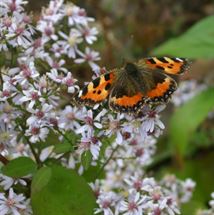
Your garden can provide a source of pollen and nectar to late flying insects long after native wild flowers have finished. This is one of the features that can make gardens specially good habitats. Members of the Daisy family (Asteraceae) are the autumn mainstay - Aster, Symphyotrichum (the new name for North American Michaelmas Daisies), and perennial Helianthus such as the hybrid 'Lemon Queen'. Plant in a sunny, sheltered location.
The image shows a Small Tortoiseshell butterfly nectaring from Symphytum cordifolium in my grden on 28th October. This species of butterfly has suffered a decline in the UK in recent times, possibly because of a disease. When I was younger it was really common, but nowadays I rarely see it.
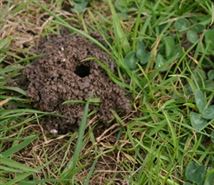
This distinctive reddish coloured bee lives in gardens lawns. It emerges in spring leaving small piles of crumbly soil around the hole from which it emerged. You can now submit online records of this bee to BWARS. Our knowledge of the distribution and abundance of this bee is very patchy and your contribution will help its conservation.
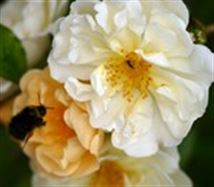
Did you know that some types of garden Roses are used as a pollen source by bumblebees? Try growing one of the following: ‘Frances E Lester’, ‘Goldfinch’ (illustrated), ‘Kew Rambler’, or ‘Veilchenblau’. All of these are large-growing climbers that need plenty of space. More compact are the shrub Roses Rosa gallica ‘Complicata’, and R. moyesii ‘Geranium’.
Pick of the bunch is probably ‘Frances E Lester’, which attracts a range of insects including some solitary bees and hoverflies.
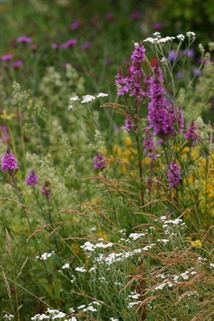
The first results have been published from the RHS 'Plants for Bugs' project. This tested the relationship between invertebrates and separate groups of plants from the UK, from the rest of the northern hemisphere, and from the southern hemisphere. The project involved several years of meticulous observation and recording. The results are interesting and important, as they are the first to deal in a scientifically robust manner with a controversy that has dogged wildlife gardening for many years: are native plants better for wildlife?
The first results deal with pollinating insects. They showed little difference between the plots for the UK and the rest of the northern hemisphere as far as insects were concerned, but that plants in the southern hemisphere plot were less attractive. The RHS planting advice based on these results is as follows:
- The best strategy for gardeners wanting to support pollinating insects in gardens is to plant a mix of flowering plants from different countries and regions.
- Emphasis should be given to plants native to the UK and the northern hemisphere.
Read the full results here.
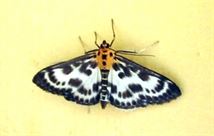
There are over 3,000 species of moths in Britain. Many are found in gardens. Much is still to be discovered about their feeding preferences, in particular to what extent adult moths take nectar from flowers, and what flowers they use. The study of moths is one of those areas where ordinary gardeners can still make a big contribution to our knowledge. Moth Night is the annual celebration of moth recording throughout Britain and Ireland by enthusiasts with local events aimed at raising awareness of moths among the general public. Find out about how to get involved by visiting the Moth Night website.
Copyright © Marc Carlton 2006 - 2020. See 'About this Website' for terms of use.
